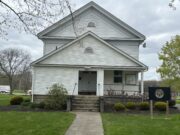Garrettsville – The holidays are prime time for devastation-turned-redemption dramas. For a real-time example, look no further than downtown Garrettsville and its restored historic district on Main Street. A little before-and-after reminder is in order, now that buildings are beautiful, lights are twinkling, and businesses are bustling.
Just three short years ago, Main Street was in shambles. The sagging Buckeye Block Building was so dilapidated, it was a public hazard and was about to be demolished. Its shabby appearance did not help neighboring establishments in their efforts to attract customers, and business housed in the building were barely hanging on. Serious decline began when the building’s largest occupant, Irwin Hardware, sold out in 2002. The new buyer sat on the property, leaving it vacant and subject to deterioration for a decade.
But let’s start at the beginning. Garrettsville officially became a village in 1864, and the Buckeye Block was the first large building to be constructed in the municipality. Built by Asa Nelson and Eugene Francis Case, it housed a hardware business operated by A.A. Barber and Enos Smith. Additional stores opened up on the main floor, and Buckeye Hall, a 400-seat auditorium, was unveiled on the second floor in the fall of 1868. Dances and live musical and theatrical performances were held there as late as 1925, with Layer’s Grocery operating beneath it for many years thereafter. But over time, Garrettsville’s grocery business migrated out to the plazas, where there was room to build modern stores and provide ample parking. Thousands of handwritten Layer’s IGA store receipts from the 1940s still sit in boxes stacked in the now-abandoned upper rooms. Empty glass soda bottles bearing now-obsolete Clicquot Club and Saegertown labels also congregate on the wooden floorboards, gathering dust.
In 2010, the condition of the Buckeye Block Building had deteriorated to the extent that the front face of the edifice was buckling over the sidewalk, and officials seriously considered demolishing the building before it became a serious public hazard. If they proceeded with this plan, four businesses that operated in it would become casualties: Garrettsville Foot & Ankle Clinic, Hearth & Home Fireplace Shoppe, Shiffer’s Clock Repair, and Miller’s Lawn & Garden. And at the heart of the sagging building was the long-vacant Irwin Hardware space.
Garrettsville Village Council was initially hesitant to allocate public monies for a privately-owned building, but even detractors agreed they had no choice but to act before winter weather set in and caused even more structural damage. Even if Council had decided to tear down the building, it would have cost the village at least $100,000 then be left with a gaping hole on historic Main Street. Fears were, if this building came down, the whole block and its business potential would go down with it.
Not only would the village have lost current establishments, but historic relics, as well, including the old stage still standing in the old Buckeye Hall where William McKinley, James Garfield and other famous orators once spoke. Discussions about the stage undoubtedly evoked fading memories of Garrettsville’s Opera House, built in 1889. For 75 years, the Opera House was a village showpiece. The three-storied building –- with its imposing bell tower -– was considered the village’s cultural center for generations, hosting dances, plays, graduations, movie shows, lectures and holiday parties. It also housed village hall, an auditorium, the fire station, police headquarters and council chambers.
After 69 years, structural weaknesses were discovered and the future of the Opera House began to be questioned. Repair estimates kept increasing and the huge building became a drain on the village treasury when rental fees from the auditorium stopped flowing. The old landmark fell to the wrecking ball in 1964. Only the clock was saved in a new clock tower built 14 years later on the same site at the corner of High and Maple Streets.
In addition to this regrettable history, memories held that Mantua’s old hardware store burned down about 30 years ago, and even now Mantua’s Main Street has an empty lot where that storefront once stood, despite the village’s efforts to attract new business there.
Village Council did not want to invite that same fate to Garrettsville.
Local builder and developer Mike Maschek gave Garrettsville Village Council an offer they couldn’t refuse: Allow him possession of the building for the cost of back taxes… and he would shore up the entire building, renovate it, and secure street-level retail space for years to come. Maschek lost no time, bracing up the structure, re-roofing it, and wrapping the entire building in new, cypress-colored vinyl siding. Around each of the building’s 44 new windows are sandy-beige frames. Above each of the 20 windows facing Main Street are decorative headers, restoring the original look to the the historic building. One final detail: Electric candles set in each window, casting a warm glow on the streets below.
Maschek also bought out the privately-owned second-and third-floor portions of the building. On the street level, Maschek now owns all the retail space except for Shiffer’s Clock Repair. One Real Peach now occupies the Irwin Hardware space. Maschek Construction is planning to move its office to a portion of the now-vacant Hearth & Home space. The other half will likely be leased to another establishment after the first of the year. Miller’s Lawn & Garden, the foot clinic and clock shop take up the rest of the Main Street space, while Garrettsville-Nelson Community Food Bank and T&B Tools occupy the space around the corner, along Center Street.
Garrettsville’s Preservation/Historic District has come a long way. The Buckeye Block Building’s street-level retail space is nearly filled and foot traffic is brisk. What remains to be seen is the fate of the upper levels, which still sit frozen in some long-lost time, waiting for a tantalizing breath of revitalization and restoration. Maybe we’ll discover that rags-to riches story in The Villager’s next Thanksgiving edition.
Photographs by Estelle R. Brown & Benjamin Coll
[hr] [related_posts limit=”5″]
















